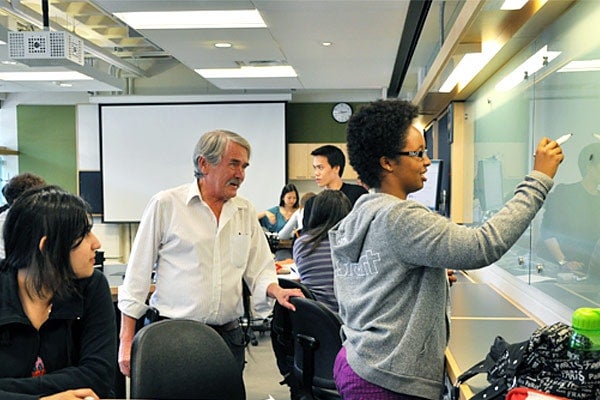
Great teaching at U of T: from student feedback to faculty mentors
Published: September 21, 2012
From elementary schools to universities, everyone’s talking about innovative teaching. But what does it mean – and how do you make it happen?
Enter the Centre for Teaching Support & Innovation (CTSI) at U of T.
“We know so much more from research about what contributes to effective teaching than we did, say 30 years ago,” says Carol Rolheiser, director of CTSI. “The purpose of innovative teaching is to help us realize particular goals and outcomes we want for our students in our higher education classes.
“Those goals continue to become more ambitious.”
CTSI helps faculty members develop and enhance their knowledge and teaching skills through support networks, course evaluations, and training offered at workshops, courses and events held throughout the year. Training topics are varied but include: course and assignment design; effective lesson planning; and online communication and collaboration tools.
“We attract amazing students, and so, we want to ensure that our U of T students have the best learning experiences in their courses” says Rolheiser. “Teaching innovation is about continuing to improve what we’re doing: critiquing what we’re doing, building on what we’re doing, and creating a culture where instructors learn from one another and implement great ideas.”
The workshops helped psychology lecturer Kristie Dukewich before she even set foot in her classroom.
“All of the workshops I attended have impacted my teaching in some way; there wasn't a single one that I didn't feel like I got something really important out of it,” she says, adding that the CTSI workshops led to her drastically changing her original class syllabi and teaching approach. “The three biggest changes I made to my syllabi and teaching approach were to (1) spend some extra time deciding what my first lecture was going to be like (2) incorporate partner and group discussions and (3) to share my marking rubric for written assignments.”
Teaching staff aren’t the only instructors who receive support from the CTSI. All first-contract teaching assistants go through the Teaching Assistants’ Training Program (TATP) to prepare them for their duties. The training covers the essentials necessary to become an effective TA such as: marking, classroom management, providing feedback, and working within university policies. TAs also have the option to enroll in a one-year Teaching Fundamentals or two-year Advanced University Teaching Preparation certificate program.
“[TATP] helps TAs improve the practices that are closely connected to learning and the student experience in the classroom,” says Sara Carpenter, acting assistant director of CTSI and TATP. “We provide opportunities for TAs to learn to work with students in an equitable manner than supports university policies and best practices in undergraduate and graduate instruction.”
Teaching assistants are crucial elements of any class; Berivan Esen, a TA from the Department of Earth Sciences, says the skills she learned from the TATP will be important for her success.
“As a TA you’re a bridge between the students and the professor,” says Esen. “It’s important to understand the role and influence you have on someone’s education, and the responsibility that comes along with that.”
“I like to see my TAs and myself as a team working together to help students,” says Geology senior lecturer Charly Bank. “TAs tend to be closer to the students in terms of undergraduate experience, and so they can relate more easily to problems students may face.”
The new course evaluation framework, which asks students to evaluate their learning experiences, is another key feature of innovative teaching at U of T. The questions were designed with input from students and faculty to provide meaningful information that benefits both groups. The CTSI, working collaboratively with divisions and departments, has been working to ensure that the new framework better serves those who rely on its results.
“We were finding that [faculty] weren’t having an easy time interpreting the data to make significant changes to their teaching,” says Pam Gravestock, associate director, CTSI. “They wanted some meaningful information to make changes.”
Consultation with students highlighted that environmental sustainability issues associated with paper evaluations were a huge concern for students. To meet this need, the new framework uses an online system so student feedback can be easily collected, analyzed and implemented in future teaching.
“The new course evaluation offered the opportunity to help design more helpful and well-crafted questions that could be truly useful to instructors in understanding the strengths and weaknesses of their teaching,” says University of Toronto Mississauga Sociology professor Shyon Baumann. “The first thing we are noticing is that this system is a much lighter administrative burden - it is already saving hours of work.”
The course evaluation is also proving popular with students, says Dr. Ann Tourangeau of the Lawrence S. Bloomberg Faculty of Nursing, which implemented the framework a year ago.
“We’re very pleased with how our students have embraced [the online system],” she says.
Moving course evaluations online has also provided students with the opportunity to provide thoughtful feedback according to their own personal schedules. As of this fall, Nursing, Arts and Science, U of T Mississauga, U of T Scarborough, and Factor-Inwentash Faculty of Social Work will be fully using the new course evaluation framework, says Gravestock. CTSI is also working with the Faculty of Information Studies among other divisions to expand the impact of the new framework.
Established in 2009, CTSI was created when the Office of Teaching Advancement and the Resource Centre for Academic Technology merged. With so many opportunities, Rolheiser is optimistic about teaching innovation at U of T.
“What makes U of T unique is we have world class researchers and the best students. Connect that with high quality teaching, and it’s a recipe for success.”



